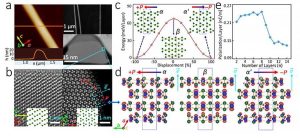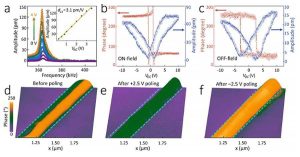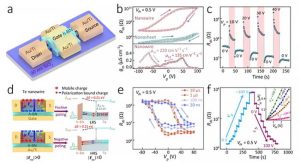From Tohoku University, Room-Temperature Ferroelectricity and Storage Potential in Tellurium Nanowires
Scientists has revealed room-temperature ferroelectric and resistive switching behaviors in single-element Te nanowires, paving way for advancements in high-density storage and neuromorphic computing.
This is a Press Release edited by StorageNewsletter.com on December 5, 2024 at 2:00 pmFrom Tohoku University, Sendai, Japan
A groundbreaking discovery by an international team of scientists has revealed room-temperature ferroelectric and resistive switching behaviors in single-element tellurium (Te) nanowires, paving the way for advancements in ultrahigh-density data storage and neuromorphic computing.
Published in Nature Communications, this research marks the first experimental evidence of ferroelectricity in Te nanowires, a single-element material, which was previously predicted only in theoretical models.
“Ferroelectric materials are substances that can store electrical charge and keep it even when the power is turned off, and their charge can be switched by applying an external electric field – a characteristic essential for non-volatile memory applications,” points out Professor Yong P. Chen, co-corresponding author of the paper, a principal investigator at Tohoku University‘s Advanced Institute for Materials Research (AIMR) and a professor at Purdue and Aarhus Universities.
Polar structure and ferroelectric polarization.
© Jinlei Zhang, Jiayong Zhang, Yaping Qi et al.
While ferroelectricity is common in compounds, single-element materials like Te rarely exhibit this behavior due to their symmetric atomic structures.
However, Chen and his colleagues demonstrated that Te nanowires exhibit robust ferroelectric properties at room temperature, thanks to the unique atomic displacement within their one-dimensional chain structure. The discovery was made using piezoresponse force microscopy (PFM) and high-resolution scanning transmission electron microscopy.
Building on this discovery, the team developed a novel device – a self-gated ferroelectric field-effect transistor (SF-FET) – which integrates both ferroelectric and semiconducting properties in a single device. The SF-FET demonstrates exceptional data retention, fast switching speeds of less than 20 nanoseconds, and an impressive storage density exceeding 1.9TB/square centimeter.
Ferroelectric hysteresis and domain switching.
©Jinlei Zhang, Jiayong Zhang, Yaping Qi et al.
“Our breakthrough opens up new opportunities for next-generation memory devices, where Te nanowires’ high mobility and unique electronic properties could help simplify device architectures,” says Yaping Qi, assistant professor at AIMR and co-first author of the study. “Our SF-FET device could also play a crucial role in future artificial intelligence systems, enabling neuromorphic computing that mimics human brain function. Additionally, the findings can help lead to lower power consumption in electronic devices, addressing the need for sustainable technology.“
Currently, the team at AIMR, which comprises Qi and Chen, is exploring new 2D, ferroelectric materials using AI techniques, in collaboration with Professor Hao Li’s group. This could lead to the discovery of more materials with promising ferroelectric properties or further applications beyond memory storage, such as neuromorphic computing.
Switching characteristics exhibiting NVM of Te nanowire self-gated ferroelectric field effect transistor (SF-FET).
©Jinlei Zhang, Jiayong Zhang, Yaping Qi et al.
Resources:
Breaking the energy barrier: Advancements in phase-change memory technology
Article: Room-temperature ferroelectric, piezoelectric and resistive switching behaviors of single-element Te nanowires
Nature Communications has published an article written by Jinlei Zhang, Key Laboratory of Inteligent Optoelectronic Devices and Chips of Jiangsu Higher Education Institutions, School of Physical Science and Technology, Suzhou University of Science and Technology, Suzhou, China, Advanced Technology Research Institute of Taihu Photon Center, School of Physical Science and Technology, Suzhou University of Science and Technology, Suzhou, China, and Laboratory of Solid State Microstructures, Nanjing University, Nanjing, China, Jiayong Zhang, Key Laboratory of Inteligent Optoelectronic Devices and Chips of Jiangsu Higher Education Institutions, School of Physical Science and Technology, Suzhou University of Science and Technology, Suzhou, China, Yaping Qi, Department of Engineering Science, Faculty of Innovation Engineering, Macau University of Science and Technology, Macau SAR, China, and Advanced Institute for Materials Research, Tohoku University, Sendai, Japan, Shuainan Gong, Hang Xu, Zhenqi Liu, Ran Zhao, Key Laboratory of Inteligent Optoelectronic Devices and Chips of Jiangsu Higher Education Institutions, School of Physical Science and Technology, Suzhou University of Science and Technology, Suzhou, China, Mohammad A. Sadi, Demid Sychev, Department of Physics and Astronomy and Elmore Family School of Electrical and Computer Engineering and Birck Nanotechnology Center and Purdue Quantum Science and Engineering Institute, Purdue University, West Lafayette, IN, USA, Run Zhao, Key Laboratory of Inteligent Optoelectronic Devices and Chips of Jiangsu Higher Education Institutions, School of Physical Science and Technology, Suzhou University of Science and Technology, Suzhou, China, Hongbin Yang, Institute of Materials Science & Devices, Suzhou University of Science and Technology, Suzhou, China, Zhenping Wu, State Key Laboratory of Information Photonics and Optical Communications & School of Science, Beijing University of Posts and Telecommunications, Beijing, China, Dapeng Cui, Department of Physics and Astronomy, University of Tennessee, Knoxville, TN, USA, Lin Wang, School of Materials Science and Engineering, Shanghai University, Shanghai, China, Chunlan Ma, Key Laboratory of Inteligent Optoelectronic Devices and Chips of Jiangsu Higher Education Institutions, School of Physical Science and Technology, Suzhou University of Science and Technology, Suzhou, China, Xiaoshan Wu, Advanced Technology Research Institute of Taihu Photon Center, School of Physical Science and Technology, Suzhou University of Science and Technology, Suzhou, China, Ju Gao, Key Laboratory of Inteligent Optoelectronic Devices and Chips of Jiangsu Higher Education Institutions, School of Physical Science and Technology, Suzhou University of Science and Technology, Suzhou, China, and School for Optoelectronic Engineering, Zaozhuang University, ZaoZhuang, Shandong, China, Yong P. Chen, Advanced Institute for Materials Research, Tohoku University, Sendai, Japan, Department of Physics and Astronomy and Elmore Family School of Electrical and Computer Engineering and Birck Nanotechnology Center and Purdue Quantum Science and Engineering Institute, Purdue University, West Lafayette, IN, USA, and Institute of Physics and Astronomy and Villum Center for Hybrid Quantum Materials and Devices, Aarhus University, Aarhus, Denmark, Xinran Wang, School of Integrated Circuits, Nanjing University, Suzhou, China, National Laboratory of Solid State Microstructures, School of Electronic Science and Engineering and Collaborative Innovation Center of Advanced Microstructures, Nanjing University, Nanjing, China, Interdisciplinary Research Center for Future Intelligent Chips (Chip-X), Nanjing University, Suzhou, China, and Suzhou Laboratory, Suzhou, China, and Yucheng Jiang, Key Laboratory of Inteligent Optoelectronic Devices and Chips of Jiangsu Higher Education Institutions, School of Physical Science and Technology, Suzhou University of Science and Technology, Suzhou, China, and Advanced Technology Research Institute of Taihu Photon Center, School of Physical Science and Technology, Suzhou University of Science and Technology, Suzhou, China.
Abstract: “Ferroelectrics are essential in memory devices for multi-bit storage and high-density integration. Ferroelectricity mainly exists in compounds but rare in single-element materials due to their lack of spontaneous polarization in the latter. However, we report a room-temperature ferroelectricity in quasi-one-dimensional Te nanowires. Piezoelectric characteristics, ferroelectric loops and domain reversals are clearly observed. We attribute the ferroelectricity to the ion displacement created by the interlayer interaction between lone-pair electrons. Ferroelectric polarization can induce a strong field effect on the transport along the Te chain, giving rise to a self-gated ferroelectric field-effect transistor. By utilizing ferroelectric Te nanowire as channel, the device exhibits high mobility (~220 cm2·V−1·s−1), continuous-variable resistive states can be observed with long-term retention (>105 s), fast speed (<20 ns) and high-density storage (>1.92 TB/cm2). Our work provides opportunities for single-element ferroelectrics and advances practical applications such as ultrahigh-density data storage and computing-in-memory devices.“


















 Subscribe to our free daily newsletter
Subscribe to our free daily newsletter


